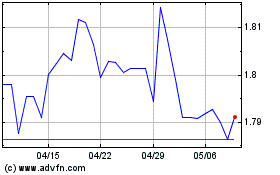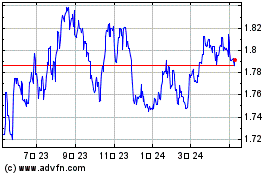Euro Weakens As German Manufacturing PMI Drops To 3-month Low
2021年5月21日 - 3:55PM
RTTF2
The euro was lower against its major counterparts in the
European session on Friday, after German manufacturing activity
eased to a three-month low in April as supply delays caused
disruption to production for businesses.
Flash survey results from IHS Markit showed that the
manufacturing PMI fell to 64.0 in May from 66.2 in the previous
month. Economists had forecast the reading to drop to 65.9.
The survey showed that supply shortages curbed production levels
and weighed on new orders due to forced downtime at customers.
Nonetheless, the composite output index advanced to 56.2 in May
from 55.8 in April. Economists had forecast a score of 57.1.
The services Purchasing Managers' Index hit a 10-month high of
52.8 versus 49.9 a month ago and the economists' forecast of 52.0.
A score above 50 indicates expansion.
In economic releases, separate data showed that the euro area
private sector activity grew the most in more than three years in
May as economies continued to open up from virus restrictions,.
The composite output index rose to 56.9 from 53.8 in the
previous month. The score was expected to climb moderately to
55.1.
The euro retreated to 1.2210 against the greenback, after
climbing to a 2-day high of 1.2240 at 2:00 am ET. If the euro
slides further, it may find support around the 1.21 level.
The euro declined to a 2-day low of 132.70 against the yen, from
a 2-day high of 133.21 seen at 8:30 pm ET. The currency may locate
support around the 129.00 level.
The euro reached as low as 0.8600 against the pound, setting a
3-day low. The next likely support for the euro lies around the
0.84 level.
Data from the Office for National Statistics showed that U.K.
retail sales expanded 9.2 percent month-on-month in April, faster
than the 5.1 percent increase in March and the economists' forecast
of +4.5 percent as non-essential stores reopened. This was the
biggest increase since June 2020, when sales were up 13.9
percent.
On a yearly basis, retail sales volume grew sharply by 42.4
percent, after rising 7.2 percent in March.
The European currency remained near a 3-day low of 1.0954
against the franc, compared to Thursday's close of 1.0968. Next
near term support for the euro is likely seen around the 1.07
level.
The euro pulled back from an early 2-day high of 1.7037 against
the kiwi and a 3-1/2-month high of 1.5798 against the aussie and
was trading at 1.6960 and 1.5731, respectively. The euro is seen
finding support near 1.66 against the kiwi and 1.54 against the
aussie.
The euro fell to a 2-day low of 1.4727 against the loonie, down
from a high of 1.4785 set at 3:00 am ET. On the downside, 1.46 is
likely seen as its next support level.
Looking ahead, Canada retail sales for March and wholesale sales
for April and U.S. existing home sales for the same month will be
published in the New York session.
At 10:00 am ET, Eurozone flash consumer sentiment index for May
will be out.
Euro vs NZD (FX:EURNZD)
FXチャート
から 3 2024 まで 4 2024

Euro vs NZD (FX:EURNZD)
FXチャート
から 4 2023 まで 4 2024
